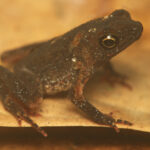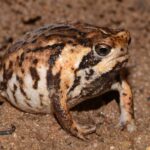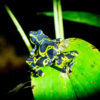- Unveiling the Hidden Life of <em>Leptodactylodon boulengeri</em>: Cameroon's Secretive Stream-Dwelling Frog
- Taxonomy and Classification
- Natural Habitat: Hidden Worlds in Cameroon's Misty Highlands
- Physical Characteristics: Subtle Beauty and Unique Adaptations
- Behavior and Life Cycle: The Rhythms of a Streamside Life
- An Ecological Keystone: Subtle Guardians of Biodiversity
- Threats and Conservation Status: The Delicate Balance Under Siege
- Cultural & Scientific Importance: Beyond the Stream Banks
- Conclusion: Safeguarding Cameroon's Silent Guardians
Unveiling the Hidden Life of Leptodactylodon boulengeri: Cameroon’s Secretive Stream-Dwelling Frog#
Deep within the mist-covered montane forests of Cameroon, hidden amidst lush vegetation, trickling streams, and moss-adorned boulders, exists a fascinating yet elusive amphibian known as Leptodactylodon boulengeri. Named to honor the notable Belgian herpetologist George Albert Boulenger, this secretive frog belongs to the family Arthroleptidae and is captivating both scientists and nature enthusiasts with its enigmatic behavior and ecological significance.
Though modest in size and understated in appearance, L. boulengeri plays a crucial role as a biological indicator, reflecting the overall health of its fragile highland forest ecosystem. Yet remarkably little is widely known about this species, prompting deeper exploration into its habitat, behaviors, and conservation status. Join us as we journey beneath the dense forest canopy to uncover the intriguing life of this Cameroonian stream-dwelling marvel.
Taxonomy and Classification#
The intricate world of amphibians often begins at the cellular level, branching outwards into diverse families and species. Leptodactylodon boulengeri falls under the kingdom Animalia, phylum Chordata, class Amphibia, order Anura, and family Arthroleptidae. This family is rich with species adapted particularly to forested habitats, thriving in environments where moisture and shelter abound.
The genus Leptodactylodon includes several closely related species, all sharing morphological traits and ecological preferences, yet occupying subtly distinct niches within their environment. Thanks to meticulous scientific observation and genetic analysis, this frog has been clearly distinguished from its relatives, adding nuance and value to the biodiversity studies of the Central African region.
Natural Habitat: Hidden Worlds in Cameroon’s Misty Highlands#
To fully appreciate the life and habits of Leptodactylodon boulengeri, one must visit its primary habitat: the forested highlands and montane streams within Cameroon’s moist equatorial ecosystems. This species exhibits remarkable specialization, thriving at elevations ranging typically between 800 and 1,900 meters above sea level, nestled among pristine forest streams tucked within rolling hills and steep, cloud-hung slopes.
A Forest Stream Specialist#
Within this atmospheric world, where daily rainfall and perpetual humidity sustain densely vegetated stream-sides, L. boulengeri finds its perfect haven. Clinging closely to fast-running rivulets, the frogs rely heavily on the presence of well-maintained riparian vegetation, moss-covered boulders, and submerged logs to offer cover from predators and facilitate reproductive success.
Their microhabitat choices are meticulously selected; these frogs frequently occupy areas characterized by shaded habitats, low temperatures, and consistent moisture. Such selective habitat use renders them particularly susceptible to environmental disturbance, underscoring their role as indicators for ecosystem health.
Physical Characteristics: Subtle Beauty and Unique Adaptations#
At first glance, Leptodactylodon boulengeri might appear unassuming in comparison to vibrantly colorful rainforest frogs; yet, closer inspection reveals intriguing adaptations and subtle beauty. Adults measure from approximately 28 to 40 millimeters, characterized by an earthy palette of browns, olives, and grays—perfectly matched to their shadowy, moss-strewn surroundings.
The skin texture, featuring granular surfaces interspersed with tiny tubercles, expertly mimics the roughened bark and moss-covered stones of their habitat. Such intricate coloration and texturing act as an impressive camouflage, guarding them against predators such as nighttime hunting snakes, birds, and mammals prowling the forest floor.
Their limbs, strong yet agile, are adapted to swift, precise movements. Powerful hind legs assist in rapid jumps across slippery stones and swift currents, while webbed digits offer a secure grip against the force of the water. Large eyes, positioned prominently on their heads, facilitate their nocturnal lifestyle, granting exceptional night-time vision vital for foraging activities.
Behavior and Life Cycle: The Rhythms of a Streamside Life#
Life for Leptodactylodon boulengeri unfolds predominantly after sunset, when thickening darkness cloaks the Cameroonian forests and exploratory insects awaken. These frogs are opportunistic insectivores, regularly feasting upon ants, small beetles, spiders, and other arthropods. Precise and efficient hunters, they rely on stealth, camouflage, and sudden strikes to secure their meal, swiftly returning to safety afterward.
Remarkable Breeding Strategies and Parental Care#
Perhaps most compelling is the species’ intriguing breeding behavior. When conditions are suitable, typically during periods of frequent rainfall, males congregate near forest streams—each voicing quiet, repetitive calls, finely tuned to compete against the hum and splash of flowing water. Females respond selectively to the best environmental locations and males who excel vocally, ensuring successful offspring production.
Notably, females attach clusters of eggs within damp, protected crevices beneath rocks in shallow water, ensuring protection from predators and stable incubation conditions. Parental care is exceptionally developed within this species: males particularly demonstrate astonishing protective behavior, diligently guarding the eggs and later, the developing larvae, until the tadpoles undergo metamorphosis into miniature adults.
An Ecological Keystone: Subtle Guardians of Biodiversity#
Within their role in Cameroon’s forested ecosystems, Leptodactylodon boulengeri fulfills multiple ecological functions. Predating numerous insects and invertebrates, these frogs significantly control pest insect populations, indirectly influencing plant health and biodiversity. Simultaneously, as prey, they provide essential nourishment to many larger vertebrate species. Their sensitivity to pollutants and habitat disturbance also makes them a highly reliable sentinel species, signaling the overall health and vitality of their fragile montane forest landscapes.
Threats and Conservation Status: The Delicate Balance Under Siege#
Unfortunately, the realities faced by Leptodactylodon boulengeri reflect broader ecological challenges confronting Cameroon’s valuable montane forests. Habitat destruction, primarily due to increasing agriculture, logging activities, and human settlements, poses the most profound threat. Habitat fragmentation isolates populations, restricts gene flow, and threatens long-term population viability.
According to the International Union for Conservation of Nature (IUCN), L. boulengeri is categorized as Near Threatened (NT). While not yet severely endangered, scientists emphasize the species’ sensitivity and urge the need for proactive intervention to prevent further declines.
Active Conservation Initiatives#
Efforts to protect montane forests, like improved forestry management, establishment of protected areas, and community-based conservation projects, help provide safe havens for L. boulengeri. Educational outreach initiatives aimed at local communities also serve vital roles, fostering awareness and understanding of the essential ecological role that amphibians play in maintaining overall ecosystem health.
Cultural & Scientific Importance: Beyond the Stream Banks#
While cultural ties to this specific species remain minimal, Leptodactylodon boulengeri is gaining scientific attention for its vulnerability and unique reproductive strategies. Studies examining its parental care and reproductive ecology have provided valuable insights, contributing broadly to amphibian biology and conservation science, with wider implications for protecting amphibian diversity globally.
Conclusion: Safeguarding Cameroon’s Silent Guardians#
From their subtle yet intriguing appearance to their extraordinary parental care and their significant ecological guardian role, Leptodactylodon boulengeri represent far more than isolated inhabitants of forest stream-beds. They portray vivid examples of the delicate interconnectedness that pulses quietly within diverse ecosystems worldwide. As their stewards, our increased awareness, education, and actions will determine the survival and flourishing of these remarkable frogs.
We invite you to join ongoing conservation efforts, participate in citizen science, and share knowledge to champion amphibian diversity. Protecting Cameroon’s secretive amphibians today secures a healthier planet for generations tomorrow.












